STONE INDUSTRY OF THE BARUN-ALAN-1, 8TH LAYER: VARIANT OF THE INITIAL UPPER PALAELITHIC FORMING IN WESTERN TRANSBAIKALIA
Abstract
Palaeolithic materials of multilayered archaeological site Barun-Alan-1 situated on the east of the Western Transbaikal were collected from two main lithological layers — 7 and 7g. At the same time the materials of the 7th layer distinctively differ from materials of the 7g layer that allows considering them as two different cultures (industries). Materials from the 7th layer and from the lower part of the 6th layer are distinguished as a separate archaeological culture named Khengerekte-Sukhotino. This culture existence time spans the period of sartan cooling in a whole. Archaeological materials of the 7g layer, laid under layer 7, have a series of similar features with the materials of the Western Transbaikalian Tolbaga culture dating back to the Initial Upper Palaeolithic. Taking into account natural science and chronological data obtained for the 7g layer, 7g layer was deposited in the period of the Karga interstadial, this fact indicated simultaneous development of the 7g industry and Tolbaga archaeological culture. Despite a series of similar characteristics between the industries of 7g layer and Tolbaga culture, there are distinctive diversities. First of all, it is figured out in levallois technique, which is presented in Barun-Alan-1 7g layer by classic variant, and also in dierent approaches to tools maintainence. The materials of the 8 layer which are analyzed entirely for the first time show the similarity with 7g layer materials and give supplementary information about time of the penetration of this industry presumably from Central Mongolia and as early as at the final stage of the Middle Palaeolithic or at the transitional stage from Middle to Upper Palaeolithic.Downloads
Metrics
References
Antonova Yu.E., Tashak V.I. Stone Industry of the South-Eastern Complex Podzvonkaya: General Characteristics. Izvestiya Irkutskogo gos. un-ta. Ser.: Geoarheologiya. Etnologiya. Antropologiya = Bulletin of the Irkutsk State University. Geoarchaeology, Ethnology, and Anthropology Series. 2016;3:3–20. (In Russ.)
Derevianko A.P. The Upper Palaeolithic in Africa and Eurasia and the Origin of Anatomically Modern Humans. Novosibirsk : Izd-vo In-ta arheologii i etnografii SO RAN, 2011. 560 p. (In Russ.)
Derevyanko A.P., Kandyba A.G., Petrin V.T. Paleolithic of Orkhon. Novosibirsk : Izd-vo In-ta arheologii i etnografii SO RAN, 2010. 384 p. (In Russ.)
Derevianko A.P., Zenin A.N., Rybin E.P., Gladyshev S.A., Tsybankov A.A., Olsen J.W., Tseveendorj D., Gunchinsuren B. The Technology of Early Upper Paleolithic Lithic Reduction in Northern Mongolia: the Tolbor-4 Site. Arheologiya, etnografiya i antropologiya Evrazii = Archaeology, Ethnography and Anthropology of Eurasia. 2007;1:16–38. (In Russ.)
Lbova L.V. Paleolithic of the Northern Part of Western Transbaikal. Ulan-Ude : Izd-vo BNC SO RAN, 2000. 240 p. (In Russ.)
Lvova E.M., Grigorieva A.I. Subresent Spore-Pollen Spectra of Modern Vegetatio. In: Methodological Questions of Palynology. Moscow : IGiRGI, 2002. Pp. 126–127. (In Russ.)
Rybin E.P. Chronology and Geographical Distribution of Culture-Significant Artifacts in the Initial Upper Paleolithic of North Asia and Eastern Part of Central Asia. Izvestiya Altaiskogo gosudarstvennogo universiteta = The Bulletin of Altai State University. 2014;4–1(84):188–198. doi:10.14258/izvasu(2014)4.1-32 (in Russ.)
Rybin E.P., Antonova Yu.E, Tashak V.I., Kobylkin D.V., Khatsenovich A.M., Gunchinsuren B. Early Stages of the Upper Paleolithic in the Selenga River Basin: Technological Variability, Subsistence, Settlement Systems. Stratum plus. 2022;1:285–328. (In Russ.) https://doi.org/10.55086/sp221285328
Rybin E.P., Kandyba A.V., Khatsenovich A.M., Slavinskij V.S. Variability and Chronostratigraphy of Levallois Technology in Middle and Initial Upper Paleolithic of Mongolia. Vestnik Novosibirskogo gosudarstvennogo universiteta. Ser.: Istoriya, filologiya = Novosibirsk State University Bulletin. Series: History, Philology. 2015;14(3):37–48. (In Russ.)
Rybin E.P., Slavinsky V.S. Levallois Convergent Unidirectional Typical Technology in Southern Siberia and the Northern Part of Central Asia: Variability, Distribution, Chronology. Stratum plus. 2015;1:285–308. (In Russ.)
Rybin E.P., Khatsenovich A.M., Marchenko D.V. Model of Technological Development in the Industries of Early Stages of the Upper Paleolithic in Northern Mongolia: according to the Results of New Excavations of the Tolbor-4 Site. Teoriya i praktika arheologicheskih issledovanij = Theory and Practice of Archaeological Research. 2019;4:164–179. (In Russ.) https://doi.org/10.14258/tpai(2019)4(28).-12.
Slavinskiy V.S. Stone Knapping in the Final Middle and Initial Upper Paleolithic Industries of the Kara-Bom Site as Revealed by the Results of Refitting Analysis (technology, closest analogies, chronology). Pervobytnaya arheologiya. Zhurnal mezhdisсiplinarnyh issledovapnij = Prehistoric Archaeology. Journal of Interdisciplinary Studies. 2021;1:5–51. (In Russ.)
Slavinsky V.S., Rybin E.P., Belousova N.E. Variation in Middle and Upper Paleolithic Reduction Technology of Kara-Bom, the Altai Mountains: Refitting Studies. Arheologiya, etnografiya i antropologiya Evrazii = Archaeology, Ethnology & Anthropology of Eurasia. 2016;1(44):39–50. DOI:10.17746/1563-0102.2016.44.1.039-050 (In Russ.)
Tashak V.I. Stratigraphy and Chronology of Khengerekte Mountain’s Paleolithic Sites (Western Transbaikalia). Vestnik Novosibirskogo gosudarstvennogo universiteta. Ser.: Istoriya, filologiya = The Bulletin of Novosibirsk State University. Ser.: History and Philology. 2009;8(3):53–62. (In Russ.)
Tashak V.I. End-scrapers in the stone industry of Eastern Complex at Podzvonkaya site (the Republic of Buryatia). In: Esse quam videri: to the 80th Anniversary of the Birth of German Ivanovich Medvedev. Irkutsk : Izd-vo IGU, 2016. Pp. 197–203. (In Russ.)
Tashak V.I. The Blades in the Industry of Layer 7g of the Paleolithic Site Barun-Alan-1 in Transbaikalia. Teoriya i practika arheologicheskih issledovanij = Theory and Practice of Archaeological Research. 2018a;4(24):39–54. (In Russ.)
Tashak V.I. Levallois Technique in the Paleolithic of Transbaikalia. Stratum plus.2018b;1:327–338. (In Russ.)
Tashak V.I. New Research on Chronology of Barun-Alan-1 Site (the Republic of Buryatia). Izvestiya Laboratorii drevnih tehnologij = Journal of Ancient Technology Laboratory. 2019;15(1):9–19. (In Russ.) DOI: http://dx.doi.org/10.21285/2415-8739-2019-1-9-19.
Tashak V.I. Khengerekte-Sukhotino — an Upper Paleolithic Culture in Transbaikalia. Arheologiya, etnografiya i antropologiya Evrazii = Archaeology, Ethnology & Anthropology of Eurasia. 2023a;51(3):109–115. (In Russ.) doi:10.17746/1563-0102.2023.51.3.109-115
Tashak V.I. Levallois Points in Barun-Alan-1 7g Layer Industry (Western Transbaikal). In: Problems of Archaeology, Ethnography, Anthropology of Siberia and Neighboring Territories. Vol. XXIX. Novosibirsk : Izd-vo In-ta arheologii i etnografii SO RAN, 2023b. Pp. 334–338. (In Russ.) https://doi:10.17746/2658-6193.2023.29.0334-0338
Tashak V.I., Antonova Yu.E. Stone Industry from Layer 7g of Barun-Alan-1 and the Variability of the Initial Upper Palaeolithic of Western Transbaikalia. Stratum plus. 2024;1:231–255. (In Russ.) https://doi.org/10.55086/sp241231255
Tashak V.I., Reshetova S.A., Antonova Yu.E. Reconstruction of the Human Environment in the Basin of the River Udy in the Late Pleistocene — Holocene on the Materials of the Archaeological Site of Barun-Alan-1 (Western Transbaikalia). Izvestiya Irkutskogo gos. un-ta. Ser.: Geoarheologiya. Etnologiya. Antropologiya = Proceedings of Irkutsk State University. Ser.: Geoarheology. Ethnology. Anthropology. 2017;20:3–25. (In Russ.)
Rose J.I., Usik V.I., Marks A.E., Hilbert Ya.H., Galletti C.S., Parton A., Geiling J.M., Cerny V., Morley M.W., Roberts R.G. The Nubian Complex of Dhofar, Oman: An African Middle Stone Age Industry in Southern Arabia. PLoS ONE. 2011;6(11):е28239. https://doi.org/10.1371/journal.pone.0028239
Rybin E.P. Tools, Beads, and Migrations: Specific Cultural Traits in the Iinitial Upper Paleolithic of Southern Siberia and Central Asia. Quaternary International. 2014;347:39–52.
Van Peer P. Interassemblage Variability and Levallois Styles: The Case of the Northern African Middle Palaeolithic. Journal of Anthropological Archaeology. 1991;10:107–151.
Zwyns N., Lbova L.V. The Initial Upper Paleolithic of Kamenka Site, Zabaikal Region (Siberia): a Closer Look at the Blade Technology. Archaeological Research in Asia. 2019;17:24–49.
Copyright (c) 2024 В.И. Ташак

This work is licensed under a Creative Commons Attribution 4.0 International License.
Theory and Practice of Archaeological Research is a golden publisher, as we allow self-archiving, but most importantly we are fully transparent about your rights.
Authors may present and discuss their findings ahead of publication: at biological or scientific conferences, on preprint servers, in public databases, and in blogs, wikis, tweets, and other informal communication channels.
Theory and Practice of Archaeological Research allows authors to deposit manuscripts (currently under review or those for intended submission to ABS) in non-commercial, pre-print servers such as ArXiv.
Authors who publish with this journal agree to the following terms:
- Authors retain copyright and grant the journal right of first publication with the work simultaneously licensed under a Creative Commons Attribution License (CC BY 4.0) that allows others to share the work with an acknowledgement of the work's authorship and initial publication in this journal.
- Authors are able to enter into separate, additional contractual arrangements for the non-exclusive distribution of the journal's published version of the work (e.g., post it to an institutional repository or publish it in a book), with an acknowledgement of its initial publication in this journal.
- Authors are permitted and encouraged to post their work online (e.g., in institutional repositories or on their website) prior to and during the submission process, as it can lead to productive exchanges, as well as earlier and greater citation of published work (See The Effect of Open Access).








2.jpg)




